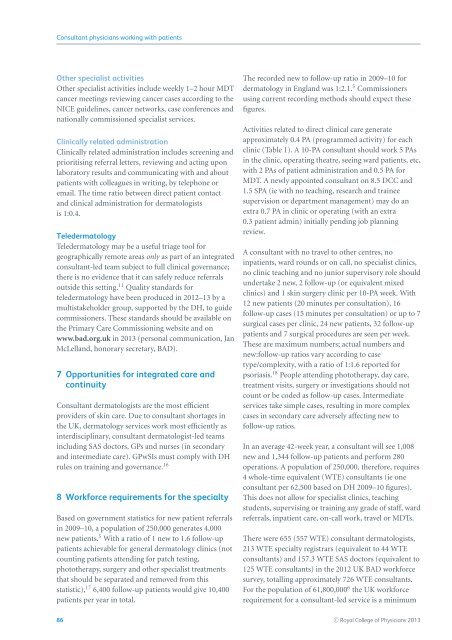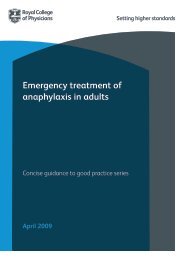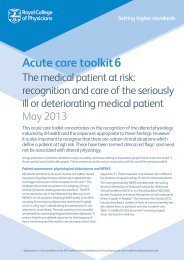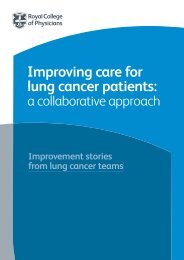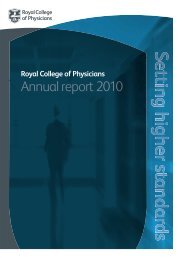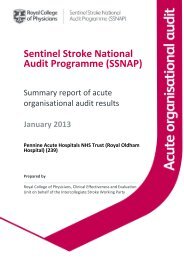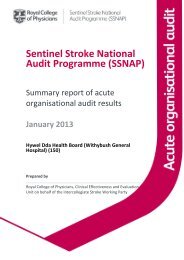Consultant physicians working with patients - Royal College of ...
Consultant physicians working with patients - Royal College of ...
Consultant physicians working with patients - Royal College of ...
You also want an ePaper? Increase the reach of your titles
YUMPU automatically turns print PDFs into web optimized ePapers that Google loves.
<strong>Consultant</strong> <strong>physicians</strong> <strong>working</strong> <strong>with</strong> <strong>patients</strong>Other specialist activitiesOther specialist activities include weekly 1–2 hour MDTcancer meetings reviewing cancer cases according to theNICE guidelines, cancer networks, case conferences andnationally commissioned specialist services.Clinically related administrationClinically related administration includes screening andprioritising referral letters, reviewing and acting uponlaboratory results and communicating <strong>with</strong> and about<strong>patients</strong> <strong>with</strong> colleagues in writing, by telephone oremail. The time ratio between direct patient contactand clinical administration for dermatologistsis 1:0.4.TeledermatologyTeledermatology may be a useful triage tool forgeographically remote areas only as part <strong>of</strong> an integratedconsultant-led team subject to full clinical governance;there is no evidence that it can safely reduce referralsoutside this setting. 11 Quality standards forteledermatology have been produced in 2012–13 by amultistakeholder group, supported by the DH, to guidecommissioners. These standards should be available onthe Primary Care Commissioning website and onwww.bad.org.uk in 2013 (personal communication, JanMcLelland, honorary secretary, BAD).7 Opportunities for integrated care andcontinuity<strong>Consultant</strong> dermatologists are the most efficientproviders <strong>of</strong> skin care. Due to consultant shortages inthe UK, dermatology services work most efficiently asinterdisciplinary, consultant dermatologist-led teamsincluding SAS doctors, GPs and nurses (in secondaryand intermediate care). GPwSIs must comply <strong>with</strong> DHrules on training and governance. 168 Workforce requirements for the specialtyBased on government statistics for new patient referralsin 2009–10, a population <strong>of</strong> 250,000 generates 4,000new <strong>patients</strong>. 5 With a ratio <strong>of</strong> 1 new to 1.6 follow-up<strong>patients</strong> achievable for general dermatology clinics (notcounting <strong>patients</strong> attending for patch testing,phototherapy, surgery and other specialist treatmentsthat should be separated and removed from thisstatistic), 17 6,400 follow-up <strong>patients</strong> would give 10,400<strong>patients</strong> per year in total.The recorded new to follow-up ratio in 2009–10 fordermatology in England was 1:2.1. 5 Commissionersusing current recording methods should expect thesefigures.Activities related to direct clinical care generateapproximately 0.4 PA (programmed activity) for eachclinic (Table 1). A 10-PA consultant should work 5 PAsin the clinic, operating theatre, seeing ward <strong>patients</strong>, etc,<strong>with</strong> 2 PAs <strong>of</strong> patient administration and 0.5 PA forMDT. A newly appointed consultant on 8.5 DCC and1.5 SPA (ie <strong>with</strong> no teaching, research and traineesupervision or department management) may do anextra 0.7 PA in clinic or operating (<strong>with</strong> an extra0.3 patient admin) initially pending job planningreview.A consultant <strong>with</strong> no travel to other centres, noin<strong>patients</strong>, ward rounds or on call, no specialist clinics,no clinic teaching and no junior supervisory role shouldundertake2new,2follow-up(orequivalentmixedclinics) and 1 skin surgery clinic per 10-PA week. With12 new <strong>patients</strong> (20 minutes per consultation), 16follow-up cases (15 minutes per consultation) or up to 7surgical cases per clinic, 24 new <strong>patients</strong>, 32 follow-up<strong>patients</strong> and 7 surgical procedures are seen per week.These are maximum numbers; actual numbers andnew:follow-up ratios vary according to casetype/complexity, <strong>with</strong> a ratio <strong>of</strong> 1:1.6 reported forpsoriasis. 18 People attending phototherapy, day care,treatment visits, surgery or investigations should notcount or be coded as follow-up cases. Intermediateservices take simple cases, resulting in more complexcases in secondary care adversely affecting new t<strong>of</strong>ollow-up ratios.In an average 42-week year, a consultant will see 1,008new and 1,344 follow-up <strong>patients</strong> and perform 280operations. A population <strong>of</strong> 250,000, therefore, requires4 whole-time equivalent (WTE) consultants (ie oneconsultant per 62,500 based on DH 2009–10 figures).This does not allow for specialist clinics, teachingstudents, supervising or training any grade <strong>of</strong> staff, wardreferrals, inpatient care, on-call work, travel or MDTs.There were 655 (557 WTE) consultant dermatologists,213 WTE specialty registrars (equivalent to 44 WTEconsultants) and 157.3 WTE SAS doctors (equivalent to125 WTE consultants) in the 2012 UK BAD workforcesurvey, totalling approximately 726 WTE consultants.For the population <strong>of</strong> 61,800,000 6 the UK workforcerequirement for a consultant-led service is a minimum86 C○ <strong>Royal</strong> <strong>College</strong> <strong>of</strong> Physicians 2013


